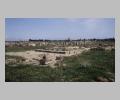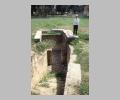| Summary: | A prosperous Greek colony. |
| Type: | Fortified city |
| Region: | Lucania |
Periods:
Archaic
Classical
Hellenistic
Physical:
Located on the gulf of Taranto between the rivers Bradaneus and Casuentus, the site was well-chosen for trade and agricultural potenital. The city was built at the site of an existing local settlement and was laid out on a rectangular grid system enclosed by a fortification wall of ca. 6 km in length. Metapontum had a small artificial harbor linked to the city by a canal. Within the city were an agora, theater, temples and a sanctuary of Apollo Lykeios. The sanctuary of Hera was located outside the city walls, ca. 3 km to the NE. The temple of Hera at the sanctuary, the so-called Tavole Palatine, is one of the best preserved monuments of Magna Graecia. North of Metapontum the agricultural land of the Greek inhabitants was divided by a rectangular grid system into a complex of individual farmsteads.
Description:
Greek colonists, possibly from Pylos, founded the city, originally called Metabum, in the 7th century B.C. Shortly thereafter the settlement was destroyed by the Samnites and then reestablished by Greek colonists from Achaea. Because of its good location for trade and the rich fertility of the surrounding territory the city grew in prosperity. Metapontum came under Roman control during the Pyrrhic War. In the 2nd Punic War the city allied itself with the Carthaginians and soon afterwards appears to have been abandoned. The most famous citizen of Metapontum was Pythagoras who came to teach here after being expelled from the city of Croton, and remained until his death.
Exploration:
Sources Used:
Other Bibliography:





